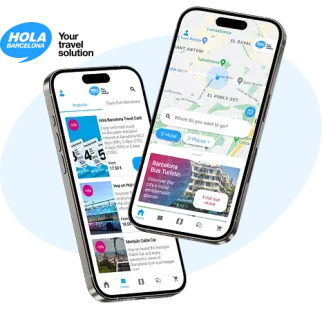El Poblenou
A former industrial district turned into an innovation showcase
The most important industrial hub during the 19th century has opened up to the sea and architecture, giving way to a peaceful, welcoming neighborhood that breathes innovation and creativity. Poblenou was completely transformed with the arrival of the Barcelona '92 Olympics, and today it is undergoing another artistic revolution.

Barcelona Bus Turístic, on the Hola Barcelona app
Your app for visiting the city with the Barcelona Bus Turístic: routes, stops and the most iconic places. A comfortable way to carry your tickets too!
Discover the trendiest part of Barcelona, where new ideas are bubbling
The neighborhood, stretching from the right end of Diagonal Avenue to the sea, was the working-class and industrial epicenter of Barcelona in the 20th century. Starting in the 1960s, an intense deindustrialization process led to the abandonment of many factories, freeing up large plots of land that were repurposed for different uses, such as lofts, studios, workshops, warehouses, and headquarters for various organizations, coexisting alongside residential buildings.
With the 1992 Olympics, a major transformation began: the Olympic Village and Olympic Port were built, and the waterfront was revitalized. Later, at the beginning of the 21st century, the city council launched the 22@ project, an ambitious urban redevelopment plan aimed at converting 200 hectares of industrial land into an innovative district strategically focused on knowledge-based activities.
Thus, in the early years of the 21st century, the neighborhood was remodeled with the construction of modern buildings such as the Glòries Tower and the Barcelona Design Museum, as well as the restoration of existing structures for new purposes, like the factory that now houses the Palo Alto artistic hub.
In recent years, Poblenou has evolved into a creative hub, with the emergence of workshops, alternative galleries, audiovisual production companies, concert venues, architectural studios, dance companies, advertising agencies, furniture stores, showrooms, artistic associations, boutique hotels, start-ups, creative schools... shaping it into the new district for arts and alternative culture in Barcelona.
Today, Poblenou offers the chance to enjoy beaches, museums, restaurants, stroll along the Rambla, admire the strikingly restored factories, and even appreciate funerary art at its cemetery, the oldest in Barcelona, where notable locals are buried.
How to get to Poblenou?
From the Glòries stop on the Red Route of the Barcelona Bus Turístic, you can reach the neighborhood by walking east.
For the curious
- In the late '80s and early '90s, Poblenou was the birthplace of Barcelona's graffiti scene, and even today, abandoned buildings and factories serve as the perfect canvas for spray artists.
- The origins of Poblenou trace back to the inhabited core of Sant Martí de Provençals and a marshland area.










